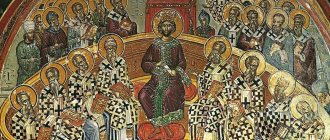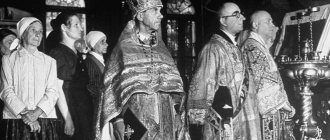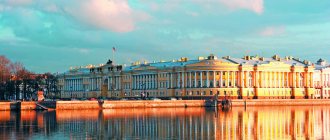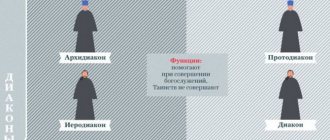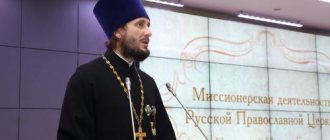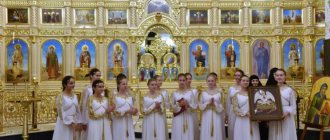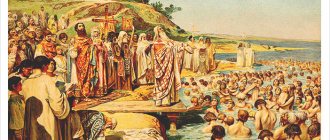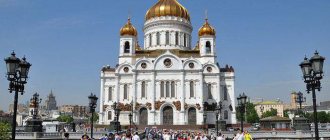"Thy will be done"
Last time we focused on how all participants in the liturgy, led by the deacon, sing the “Our Father.” We remember that this prayer, which the Lord Himself taught us in His Gospel, is preceded by the words of Christ about the need for secret prayer hidden from the world (see: Matt. 6:13 ).
This concerns a personal prayer rule that a person performs in private, shutting himself up in his room at home. And at this moment of the liturgy, each from the depths of his heart, directly in the presence of God, secretly, but at the same time, together with the entire Church, can turn to his Creator with the most secret petition. By singing “Our Father,” the entire prayer meeting expresses firm hope that the Lord will hear the prayer and grant those who ask what is “essential” for them. In order to correctly understand this main Christian prayer, priest Sergius Pravdolyubov, in his explanation of the Divine Liturgy, suggests turning to another Lord's prayer, the one that He prayed to His Father in the Garden of Gethsemane before the Passion of the Cross. One of the main points in both prayers is humility before the will of the Heavenly Father, deep acceptance of the all-good Providence of God. “And how similar these prayers are. “My Father,” He prayed as the Only Begotten Son of the Father. “Our Father,” we cry as children of the Heavenly Father by grace. “But not My will, but Yours, be done,” He said. And we surrender ourselves to His will when we say: “Thy will be done as it is in heaven and on earth” [].
In general, a Christian should not only know the Lord’s Prayer by heart, but also try to study it, that is, with the help of patristic interpretations, penetrate into the treasuries of the Lord’s Prayer hidden from a cursory, superficial perception. Many holy fathers of the Church and spiritual writers left interpretations on the “Our Father”, for example, St. John Chrysostom (Creations. Volume 8. Book 2. Explanation of the prayer “Our Father” (Matthew 4 , 9-13)), St. Ignatius Brianchaninov ( Ascetic sermon. Sermon on Tuesday of the twenty-third week), St. Nicholas of Serbia (Faith of the Saints. “Our Father.” Interpretation of the Lord’s Prayer). Even secular people who have a spiritual thirst wrote on this topic, for example, the outstanding Russian aircraft designer I.I. has very interesting reflections on the Lord’s Prayer. Sikorsky.
After the usual exclamation “For Thine is the Kingdom...”, which concludes the people’s singing of the Lord’s Prayer, the priest for the last time at the liturgy teaches peace to those praying: “Peace be with you.” “And to your spirit,” the choir usually answers. The peace of Christ is proclaimed by the priest as if from the person of Christ Himself, who is at the table, present here in the already consecrated Gifts.
Optina Pustyn
One of the country's holiest places is located in the Kaluga region among picturesque nature, surrounded by a pine forest on the banks of the Zhizdra River near the city of Kozelsk.
Reliable information about how the desert arose has not reached us. According to one legend, it was founded by the repentant robber Opta, who took the name Macarius as a monk. For a long time the monastery was called Makarieva.
The wisdom of the Optina elders earned them fame and veneration. Both rich and poor people from different parts of the country came to them for advice and help in solving everyday problems.
Famous philosophers, thinkers, and writers also visited Optina Pustyn: K. Leontiev, S. Nilus, N. Gogol, L. Tolstoy. The prototype of Elder Zosima in F. Dostoevsky’s novel “The Brothers Karamazov” is Elder Ambrose, with whom the writer communicated during a 3-day stay in the monastery and who was canonized in 1988, canonized.
There are many tragic pages in the history of Optina Pustyn. The revived monastery amazes with the beauty of its churches and its special atmosphere.
The Vvedensky Cathedral, which gave the monastery a new name - the Holy Vvedensky Optina Monastery - is the main temple, the heart and pearl of the monastery. The relics of the holy elders of the desert are kept here: Ambrose and Nektarios. A particularly revered icon of the cathedral is the Kazan Mother of God.
This is interesting: the domes of the Vvedensky Cathedral are of different colors - the central one is gold, the other four are blue with gold stars.
On the territory of the monastery, next to the main church, there is a small house where the Monk Ambrose lived. There is now a museum here, where you can not only see the interior decoration and household items of the saint, but also learn from the guides many interesting and incredible stories from his life and the fate of the monastery in different periods.
“Grace, and generosity, and philanthropy...”
Then, after the deacon’s command to bow their heads, the priest reads a secret prayer of adoration: “We give thanks to You, the invisible King, Who with Your innumerable power You have helped with all things and with the multitude of Your mercy You have brought everything from non-existence into existence. Yourself, Master, look down from heaven upon His head, which has bowed to You; not because I bowed down to flesh and blood, but to You, the terrible God. Therefore, O Master, you, who are present to all of us, level for good, according to each need: sail to those who swim, travel to those who travel, heal the sick, Physician of souls and bodies.” Bishop Vissarion (Nechaev) rightly notes about this prayer, “that in ancient times not only the sick sought healing and consolation in the communion of the Holy Mysteries, but also those who were planning to travel by land or by water admonished themselves with the Holy Mysteries” []. However, the words of the petition: “Take down what is set before us all for good, according to each need,” also speak of the need for a Christian to sanctify himself through communion with God, not only in some special life circumstances, but also for any “need.” At the same time, we ask the Lord to direct everything that He deigns to give us “for good.”
This prayer ends with the exclamation: “By the grace and compassion and love of Thy Only Begotten Son, with Him art thou blessed, with Thy Most Holy and Good and Life-giving Spirit, now and ever, and unto the ages of ages.” Once again, the priestly exclamation points us to the source of all good and its properties, that is, to God, glorified in the Holy Trinity. The remembrance of the goodness, generosity and philanthropy of our Creator is what should make our presence at the liturgy (with special internal tension for the clergy) truly terrible. We Christians, as children of God by grace, should be horrified, first of all, not by punishment, but by the betrayal of the love of our Father, revealed to us to the maximum extent in the Eucharistic Sacrifice.
While the choir is singing “Amen” in a drawn-out manner, the priest reads the last secret prayer of the liturgy: “Come, O Lord Jesus Christ our God, from Thy holy habitation and from the throne of the glory of Thy Kingdom, and come and sanctify us, Who art with the Father.” sitting down and staying here invisibly for us. And grant Thy sovereign hand to give us Thy Most Pure Body and Honest Blood, and to us all people.” It is no coincidence that we present in full the last two liturgical priestly prayers: they are never heard by those who stand in the temple, but the mood of Christians praying in the temple must correspond to this final moment of the liturgy. The priest prays to Christ: “He who sits on the mountain with the Father and dwells here invisibly for us” and “grant Your Your Most Pure Body ...” Thus, we seem to be reviewing the entire history of the redemption of the human race and the victory of Christ: the Lord abides in glory , sits on the throne of the glory of His Kingdom and at the same time dwells here with us and teaches Himself to us. All events - from the incarnation of God the Word, His preaching of the Kingdom of Heaven, prayer in the Garden of Gethsemane, the Passion of the Cross and to the Resurrection of Christ, His Ascension and the founding of the Church - all this seems to be experienced by us at one moment. Figuratively speaking, we are no longer leafing through a thick book telling of the innumerable benefits to us from God (from the gift of existence to adoption in His Kingdom), but as if we see the face of the Savior turned to us with a meek, loving, stern fatherly look. One second of this standing before God is enough to fill your entire life, even the longest one, with gratitude to God. But for this it is necessary to seek God and experience repentance. Holy people can share the experience of such vision of God. Some of the most famous examples of this kind can be found in the life of St. Seraphim of Sarov (the appearance of Christ to him during the liturgy) or in the biography of Elder Silouan of Athos, when Christ appeared to him at the very beginning of his monastic life, and this prompted St. Silouan to an amazing feat of constant striving feel the presence of God.
Holy of holies
The time has come to openly declare that no matter how diverse and sometimes serious the reasons that contributed to the emergence of such teaching and practice, they are not only not based on Tradition, but, in fact, lead to very alarming distortions of the Orthodox teaching about the Church and the Eucharist , and about the Sacrament of Repentance itself.
To be convinced of this, it is enough to recall at least a few words about the Church’s original understanding of the Sacrament of Repentance. According to the teachings of the Church, it was and still remains a sacrament of reconciliation with the Church, the return to her and into her life of those excommunicated, that is, those excluded from her Eucharistic assembly. The original, high moral standards of life that were presented to members of the Church, and the very strict church discipline allowed only one such reconciliation: “After this great and holy calling [by baptism], if anyone, having been tempted by the devil, has sinned, has only one repentance -
we read in The Shepherd of Hermas, a Christian monument of the second century.
“If one sins often and repents, it will not serve the benefit of the person who does so.”17 Later, and especially after the mass Christianization of the Empire following the conversion of Emperor Constantine, the penitential discipline was partly weakened, but the understanding of the Sacrament itself did not change at all: it was applied only to those who were excommunicated from the Church for actions and sins clearly defined in the canonical Tradition Churches18. And the fact that such an understanding of the Sacrament of Confession has remained even to this day is clearly evident from the very prayer for the remission of sins: “Reconcile and unite him (her) with the saints of your Church, in Christ Jesus our Lord...” (By the way, this very prayer is permissive and is universally used in the Orthodox Churches. As for the second prayer, unknown in many Orthodox Churches - “And I, an unworthy priest, by the authority given to me, forgive and permit...” - then it has Western origin and was introduced into our liturgical books during the times of extreme “Latinization” of Orthodox theology). Does this mean that the faithful who were not excommunicated
were considered
sinless by the Church?
Of course not. The Church teaches that no one except God is sinless, “just as there is no man who will live and not sin.” The Church has also always taught that although certain sins excommunicate a Christian, there are also those that do not lead to separation from the body of the Church and from participation in the sacraments. Nikolai Kavasila writes:
There are sins that do not lead to death, according to the teaching of St. John. And that is why nothing prevents those Christians who have not committed sins that separate them from Christ and lead to death, from partaking of the Divine Mysteries and participating in sanctification, not only in appearance, but also in reality, so that they may remain living members, one with the Head...19
This does not mean at all that our sins - our general sinfulness, weakness and unworthiness of our entire life - do not need repentance and forgiveness; All preparation for communion, as we have seen, is such repentance and a plea for forgiveness. The sacrament of Confession and the resolution of sins, which until recently was used only for those excommunicated, is not necessary. Our “non-mortal” sins and our common sinfulness
is confessed by the members of the Church every time we gather together for the Sacrament of Christ's presence, and the whole life of the Church in reality represents unceasing repentance. During the Divine Liturgy itself, we confess our sins and ask for forgiveness in the Trisagion prayer:
Forgive us every sin, voluntary and involuntary, sanctify our souls and bodies and grant us to serve You in veneration all the days of our lives...
Approaching the Holy Chalice, we ask for forgiveness for “sins, voluntary and involuntary, in word, in deed, knowledge and ignorance,” and we believe that, to the extent of our repentance, we receive forgiveness through participation in the Sacrament of true forgiveness and healing.
And then it becomes clear that the teaching that declares the Sacrament of Confession a necessary condition for the admission of the laity to Communion is not only a deviation from the genuine Church-wide Tradition, but also a distortion of the Orthodox teaching about the Church, the Eucharist and the Sacrament of Repentance itself. It distorts the teaching about the Church, since it introduces a de facto division of its members into two categories, one of which (the laity) is their rebirth in Baptism, sanctification in Holy Confirmation, the fact that they became “fellow citizens with the saints and members of God”, not recognized as a condition for full membership,
that is, participation in the Sacrament in which the Church fulfills itself as the Body of Christ and the Temple of the Holy Spirit.
It distorts the teaching about the Eucharist, because by establishing additional conditions for communion in addition to membership in the Church, it essentially does not allow us to see and experience the Eucharist as the very Sacrament of the Church, which, according to the Liturgy of St. Basil the Great, “we are all united by communion from the one Bread and Cup, united to each other into the one Holy Spirit.” And finally, it distorts the Sacrament of Repentance itself, because, having become a formality and, in fact, simply a condition for communion, confession replaces
the genuine preparation for communion, which consists, as we have seen, in true internal repentance.
The emphasis of the entire experience in this Sacrament has shifted from repentance to the remission
of sins, perceived almost at the level of magic20. This formal, semi-magical, semi-legalistic “absolution”, and not reconciliation with the Church from which sins have been excommunicated, is sought today in confession; and they are looking not because they are worried about their own sinfulness (they usually find it natural and inevitable), but because this “gives the right” to approach the Holy Gifts with a clear conscience. By becoming simply a “condition for communion,” the Sacrament of Confession, which was so decisive, so terrifying in the life of the ancient Church, today loses its true function and place in it.
How could such a teaching appear in the Church and turn into a norm, defended by many as almost the quintessence of Orthodoxy? This happened for three main reasons. We have already talked about one of them: it is nominal, minimalistic, lukewarm, disdainful
The sacraments and the attitude condemned by the Fathers to the demands of the Church, which led first to rare communion, and over time to its understanding as an “annual obligation.”
It is absolutely clear that a Christian who rarely approaches the Holy Mysteries and is completely satisfied with his de facto “excommunication” must
be reunited with the Church and cannot be admitted to the Holy Chalice without going through the Sacrament of Repentance.
The second reason, fundamentally different from the first, was the influence on the Church of monastic confession - spiritual guidance, constant “revelation of thoughts,” testing by a more experienced monk of a less experienced one. The elder to whom such spiritual guidance and confession was entrusted may not have been a priest (in its original form, monasticism was seen as incompatible with the priesthood), and this confession was not necessarily connected with the Sacrament of Penance. It was an integral part of monastic life and discipline, based on complete obedience, on the monastic renunciation of one's will. In the Byzantine monastic typikons of the 12th-13th centuries, a monk was forbidden to both begin the Chalice and abstain from it without permission, without the permission of the abbot or spiritual father, for - as it is said in one of these typikons - “to exclude oneself without permission from the sacrament is to act according to one’s own will." In women's monasteries the same power is assigned to the abbess21. Thus, we are dealing with a confession of a non-sacramental type, comparable (with appropriate changes and amendments) to what we today call “instruction” or “spiritual guidance”. Historically, however, this confession had a strong, truly decisive influence on the development of sacramental confession. In the era of spiritual decline (the depth of which is well shown by the decisions of, for example, the so-called Fifth-Sixth Council of Trullo, held in Constantinople in 691) and the loss of moral and spiritual authority by the white clergy, monasteries became almost the only centers of spiritual leadership, and monks - the only spiritual leaders and for the Orthodox people. Thus, two types of confession - “sacramental” and “spiritual” - little by little merged into one: “spiritual” becomes preparation for Holy Communion, and “sacramental” includes a resolution of spiritual problems that was not previously characteristic of it.
Such a development, no matter how historically and spiritually it was justified, no matter how beneficial it may have looked for its time, nevertheless led to confusion, which in modern conditions does more harm than good. There is not the slightest doubt about the urgent need
Churches in pastoral and spiritual leadership and mentoring. But here’s the problem: is our modern short three- to five-minute confession with a long line of confessors waiting to “fulfill their annual duty”—neither confession itself nor a full-fledged spiritual conversation—capable of satisfying this need? Another question arises: is every priest, especially a young one, fully experienced, properly “equipped” to resolve all problems and correctly understand them? How many tragic mistakes, how much spiritually harmful advice, how many misunderstandings could have been avoided if we had adhered to the essence of Church Tradition, reserved the Sacrament of Confession for those who repent of their sins, and found another time and setting for the much-needed pastoral and spiritual care, which, by the way, allows the priest himself to realize his own inadequacy in certain cases and seek help and guidance from his bishop, another priest, or from the spiritual experience of the Church.
The third and, unfortunately, the main reason was, of course, the influence of the Western scholastic and legal understanding of Repentance. Much has been written about the “Western captivity” of Orthodox theology, but few people understand the full depth and significance of the distortions to which this Western influence has led in the life of the Church itself and, above all, in the understanding of the Sacraments. Western influence has led to the aforementioned shift in the meaning of the Sacrament of Penance from repentance and reconciliation with the Church to resolution,
understood almost exclusively in terms of legal authority.
If, in the original Orthodox understanding, permission occurs because the priest is a witness
of repentance, its sincerity and reality, and
therefore
is authorized to announce and “seal” the divine forgiveness of the penitent, his accomplished “reconciliation with the Holy Church in Christ Jesus,” then Western jurisprudence puts all the emphasis on the power of the priest to forgive. Hence the completely unheard of practice of demanding and giving permission prayer without any confession! The original distinction mentioned by Cabasilas between sins that excommunicate a person from the Church and those that do not lead to such excommunication was rationalized in the West in categories on the one hand, the so-called. “mortal sins” that deprive a person of a “state of grace” and therefore require the Sacrament of Repentance and resolution, and, on the other hand, “ordinary sins” that do not affect the “state of grace”, for which internal repentance is sufficient. In the Orthodox East, especially in Russia (under the influence of the Latinizing theology of Peter Mogila and his followers), this theory turned into an obligatory combination of confession and communion. There is a sad irony in the fact that this most obvious of all Latin borrowings is presented in our country as the norm of Orthodoxy, and any attempt to revise it in the light of truly Orthodox Tradition is exposed as a Catholic deviation.
History of Holiness in Christianity
In the Old Testament you can find examples of the first prayerful invocations of saints. For example, King David mentioned the forefathers Abraham, Isaac and Israel in his appeals to God.
Already in the first centuries of Christianity, special days were established to honor people who pleased God. First of all, the apostles and first martyrs for Christ. Martyrdom was perceived as indisputable evidence of God's chosenness, the highest form of service to God. Therefore, even in the era of persecution of the first Christians, martyrs were especially revered Orthodox saints. The days of their death were considered as birthdays in the New Life. Liturgical commemorations of the martyrs were held, which united Christian communities. The relics of the martyrs were present in every temple, and their tombs became the object of pilgrimages. The memory of the martyrs was reverently preserved and passed on to new generations of Christians. Prayer books and church services were composed in honor of these saints.
It was martyrdom as the triumph of grace over death that became the first form of holiness recognized by the Church. A procedure emerged for the formal glorification of martyrs, that is, the solemn church-wide recognition of their feat and holiness. Based on the veneration of martyrs, the veneration of other saints subsequently developed. In order to celebrate the peculiarities of the life and deeds of various saints, new faces of holiness were formed. The doctrine of veneration of saints also developed as a response to heresies (false teachings).
Trinity-Sergius Lavra
The monastery in the city of Sergiev Posad, Moscow region, is the center of the country’s spiritual culture, a wonderful architectural ensemble that has absorbed the treasures of ancient Russian art and is recognized as a UNESCO World Heritage Site.
The monastery, founded by Sergius of Radonezh, is glorified by many names and events inextricably linked with the history of Russia. One of the brightest pages: Prince Dmitry Donskoy, before the Battle of Kulikovo, received the blessing of St. Sergius and two monks of the monastery - Alexander Peresvet and Andrei Oslyaba - who wished to take part in the battle with the enemies.
The reliquary with the relics of Sergius of Radonezh is kept in the Trinity Cathedral. Here you can also see the iconostasis with icons painted by Andrei Rublev and Daniil Cherny.
Pskov-Pechersky Monastery
The monastery, located in the city of Pechory, Pskov region, dates back to the 15th century, when the Assumption Church, dug out of a sand hill, was illuminated. But the monks, who fled from the south of the country from raids and devastation, settled in these places much earlier - in “God-created caves” that have survived to this day.
And in these places the monastery was more than once subject to attacks, fires, and destruction, but was restored and influenced the strengthening of the Orthodox faith in this region. This is one of the few monasteries in the country that has never been closed during its difficult, centuries-old history.
Today it is a wonderful architectural ensemble. The Assumption Cathedral houses miraculous icons: “Assumption” and “Tenderness”
By what criteria are they considered saints?
Over time, the Church began to understand how saints, Christians who especially pleased God, and also perform a conciliar prayer for them, bless believers and turn to these saints of God for support. This is the meaning of the church glorification of a person as a saint.
The reasons for it now are:
- righteous Christian life, lifetime miracles;
- posthumous miracles, duly attested;
- popular veneration based on the signs being performed.
In addition, manifestations of holiness can be;
- great services to the Church;
- martyrdom for faith;
- incorruption of the relics.
The relics of St. Alexander Svirsky in the Holy Trinity Alexander-Svirsky Monastery of the Tikhvin Diocese of the Russian Orthodox Church, located in the village of Staraya Sloboda, Lodeynopolsky district, Leningrad region, on the shore of Lake Roshchinskoye.
Some of the listed grounds may be absent when canonizing a particular saint, for example:
- perhaps little is known about his worldly life, or the “human judgment” about it is rather negative (examples - right. Simeon of Verkhoturye , at the time of the appearance of whose relics no one even remembered his name; right. youth Artemy Verkolsky , killed by lightning, which was considered a sign of a person’s dislike - so much so that he was not even given a Christian burial);
- very often the relics of a saint are not found, or are destroyed, or have been subjected to decay, and are “in the bones.”
Interesting fact
The incorruption of relics in itself is not a basis for canonization at all, if there are no other criteria, especially evidence of miracles. Moreover, for example, according to the tradition of St. Mount Athos is precisely the incorruption of the remains of a deceased monk - grounds for believing that he lived an unpleasing life; it is necessary to pray for him.
Thus, with each canonization, the issue is resolved taking into account the specific circumstances of the ascetic’s life and his veneration. But a prerequisite for glorification as a saint is posthumous miracles through prayers to him.
Right John of Kronstadt with his wife. Fragment of a photograph by K. Bulla. Beginning XX century (Central State Archive of Film and Photo Documents of St. Petersburg)
There is also no formally established period for the death of an ascetic, after which the issue of his glorification can be considered. Decades, even centuries may pass (for example, Blessed Xenia of Petersburg was glorified approximately 300 years after her death, right. John of Kronstadt a little less than 100 years later).
And some saints of God are glorified by the Church much earlier: for example, St. Paisius the Svyatogorets died in 1994, and was glorified as a saint on January 13, 2015 (since May 5 of the same year, his name has been in the Saints of the Russian Church).
Kirillo-Belozersky Monastery
It is located in the city of Kozelsk, Vologda region and is recognized as the largest monastery in Europe.
The monastery, named after its founder Cyril, arose at the end of the 14th century among impenetrable forests on the shores of Lake Siverskoye in a series of other monasteries and deserts (among them the neighboring monasteries of Ferapontov, Sergievsky and Goritsky, Nilo-Sora Hermitage), developed on annexed lands. Settlements arose around the monastic hermitages, which over time turned into cities.
There have been many trials that befell the monastic brethren over seven centuries: raids from neighboring countries trying to capture and destroy the islands of Orthodoxy.
The monastery was not surrounded by royal favor and financial support: Peter I, Ivan the Terrible, Alexander I, who visited the Northern Lavra, allocated a lot of money for its improvement, which made it possible to build beautiful churches, many of which are striking in their beauty even today.
The monastery is impressive with the size of the territory and the thickness of the walls: 11 meters high and 7 meters thick. The main temple is the Assumption Cathedral, built of stone on the site of a burnt wooden one and marking the beginning of the stone buildings of the monastery.
Since 1924, a museum-reserve has been operating on the territory of the monastery, which has collected priceless exhibits about the history of the monastery and the Vologda region.
Get ready to meet yourself
There is a very good parable on this topic. One person was asked:
- Why do you go to pray in the desert? Is it really better there than at home?
- No, not better.
- Is there another prayer?
- No, the prayer is the same.
“Then why are you leaving?”
I’m there as I am at home.”
Here in the Holy Land, man is truly not the same as at home. With the Gospel in his hands, to the best of his ability, he immerses himself in biblical events, he himself becomes a participant in them - and this is not some kind of virtual game, that now we are supposedly immersed in the Gospel. This is a real experience of the Gospel events that belong to eternity - here and now.
If a person goes on a pilgrimage with a willingness to meet a completely different self, with prayer to rethink his everyday issues, principles of existence, relationships with people, relationships with God, then the pilgrimage will be for his benefit.
How to achieve holiness
Many beginners, having read the description of the extraordinary feats of the saints, think that their repetition is the true path to holiness.
Experienced confessors, however, warn against such jealousy, pointing out that forty-day fasts with complete abstinence from food, night vigils on a pillar, and other similar feats are not the path to holiness, but... already its manifestations.
The very road that the saints of God walked is usually not described by the authors of their lives. In some way, the veil of mystery is lifted by publications about saints almost contemporary to us. An example of this is the beloved shepherd, right. John of Kronstadt:
- his canonical life describes the miracles of the great father, his zeal for worship, inspired sermons;
- Along with him there is his own spiritual diary; more or less complete editions of it have been carried out in recent years; this is the saints’ daily denunciation of themselves for their failures, their coldness towards their neighbors - and this is not false humility, he writes, as they say, with facts in hand;
- finally, there are studies of the saint’s life, according to which he had to endure a lot from his co-servants of the cathedral (a young priest burning with faith, for example, performed free services for the poor), from his wife (he decided to live with her as brother and sister, and not as wife), her relatives, whom he, according to the marriage contract, had to support with his salary (and he gave it to the poor!). This is precisely the world's usual reaction to holiness.
It is clear that under such conditions it is easy (and even, humanly speaking, excusable!) to lose one’s emotions and say a harsh word...
Is admitting one's sinfulness the beginning of holiness?
But the saint differs from the “ordinary person” in that he humbles himself and does not complain. Yes, not right away. Yes, through falls. They are, in fact, described by St. John. The path of humility is difficult, full of sorrows, which sometimes seem to be beyond measure. But having gone through them, a person confesses his weakness, recognizes himself as a sinner, and not a “great ascetic.” This is how you can make room for God’s grace.
St. John Climacus wrote:
“I did not fast, nor did I lie down, nor did I lie down on the ground; But I humbled myself, and the Lord saved me.”
It’s very simple, even, they say, joyful. And also incredibly difficult.
What is uncleanness and defilement in Orthodoxy
Orthodoxy recognizes what was accepted back in the time of the prophet. Moses, the so-called “ritual impurity”, which makes it impossible, for example, to accept the Sacraments. For example, a Christian woman will not start them during the “monthly cleansing.”
But still, real defilement is much more serious than external impurity. This is “spiritual dirt”: thoughts, sinful deeds, the general state of the soul that distances it from God. It is towards this that the spiritual struggle of the believer is directed, coupled with falls, after which it is necessary to get up and move on - even if you seem hopeless to yourself. Whether a person is holy or not is up to the Lord, who said:
“Whatever I find, that’s what I’ll judge.”
Natalia Sazonova
